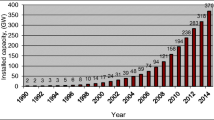Abstract
The accurate characterization of the wind characteristics of extreme wind events is crucial to the structural design and safety evaluation. However, the field-measured wind data during typhoons exhibit a strong non-stationary feature with an inherent time-varying trend which deviates from the traditional stationary assumption. This paper presents the study of non-stationary wind characteristics of Typhoon Soudelor at the Jiubao Bridge located in Hangzhou, China, which has been instrumented with a structural health monitoring system. After data classification by the stationary test, the non-stationary wind data are analyzed by both traditional stationary wind model and non-stationary wind model which considers the inherent time–varying mean wind speed. The empirical mode decomposition (EMD) and wavelet multiresolution analysis (MRA) are employed to extract the underlying trend from the original wind data as the time-varying mean wind speed for the non-stationary wind model. Based on two categories of fluctuating wind speeds obtained by removing the constant and time-varying mean wind speed, the wind characteristics including the mean wind speed, turbulence intensity, gust factor, probability distribution and power spectral density are comparatively analyzed. The results indicate that the time-varying mean wind speed can be effectively identified and extracted by the EMD and MRA. The non-stationary wind model is more appropriate than the traditional stationary wind model in the analysis of non-stationary wind speed data during a typhoon.
















Similar content being viewed by others
References
Xu YL, Zhu LD, Wong KY, Chan KWY (2000) Field measurement results of Tsing Ma suspension bridge during Typhoon Victor. Struct Eng Mech 10(6):545–559
Song L, Li QS, Chen W, Qin P, Huang H, He YC (2012) Wind characteristics of a strong typhoon in marine surface boundary layer. Wind Struct 15(1):1–15
Ye XW, Ni YQ, Wong KY, Ko JM (2012) Statistical analysis of stress spectra for fatigue life assessment of steel bridges with structural health monitoring data. Eng Struct 45:166–176
Ye XW, Su YH, Han JP (2014) Structural health monitoring of civil infrastructure using optical fiber sensing technology: a comprehensive review. Sci World J 2014:1–11
Ye XW, Su YH, Xi PS, Chen B, Han JP (2016) Statistical analysis and probabilistic modeling of WIM monitoring data of an instrumented arch bridge. Smart Struct Syst 17(6):1087–1105
Ni YQ, Ye XW, Ko JM (2010) Monitoring-based fatigue reliability assessment of steel bridges: analytical model and application. J Struct Eng ASCE 136(12):1563–1573
Ni YQ, Ye XW, Ko JM (2012) Modeling of stress spectrum using long-term monitoring data and finite mixture distributions. J Eng Mech ASCE 138(2):175–183
Oliveira G, Magalhaes F, Cunha A, Caetano E (2016) Development and implementation of a continuous dynamic monitoring system in a wind turbine. J Civ Struct Health Monit 6(3):343–353
Au SK, Zhang FL (2016) Fundamental two-stage formulation for Bayesian system identification, part I: general theory. Mech Syst Signal Process 66:31–42
Zhang FL, Au SK (2016) Fundamental two-stage formulation for Bayesian system identification, part II: application to ambient vibration data. Mech Syst Signal Process 66:43–61
Zhang FL, Ni YC, Au SK, Lam HF (2016) Fast Bayesian approach for modal identification using free vibration data, part I—most probable value. Mech Syst Signal Process 70:209–220
Brownjohn JM, De Stefano A, Xu YL, Wenzel H, Aktan AE (2011) Vibration-based monitoring of civil infrastructure: challenges and successes. J Civ Struct Health Monit 1(3–4):79–95
Yu Y, Li J, Yan N, Dackermann U, Samali B (2016) Load capacity prediction of in-service timber utility poles considering wind load. J Civ Struct Health Monit 6(3):385–394
Davenport AG (1962) Buffeting of a suspension bridge by storm winds. J Struct Div 88(3):233–270
Xu YL, Chen J (2004) Characterizing nonstationary wind speed using empirical mode decomposition. J Struct Eng ASCE 130(6):912–920
Mahato S, Teja MV, Chakraborty A (2017) Combined wavelet-Hilbert transform-based modal identification of road bridge using vehicular excitation. J Civ Struct Health Monit 7(1):29–44
Huang NE, Shen Z, Long SR (1999) A new view of nonlinear water waves: the Hilbert spectrum. Annu Rev Fluid Mech 31(1):417–457
Guo Z, Zhao W, Lu H, Wang J (2012) Multi-step forecasting for wind speed using a modified EMD-based artificial neural network model. Renew Energy 37(1):241–249
Mallat SG (1989) A theory for multiresolution signal decomposition: the wavelet representation. IEEE Trans Pattern Anal 11(7):674–693
Gurley K, Kareem A (1999) Applications of wavelet transforms in earthquake, wind and ocean engineering. Eng Struct 21(2):149–167
Liu D, Niu D, Wang H, Fan L (2014) Short-term wind speed forecasting using wavelet transform and support vector machines optimized by genetic algorithm. Renew Energy 62:592–597
Dickey DA, Fuller WA (1979) Distribution of the estimators for autoregressive time series with a unit root. J Am Stat Assoc 74(366a):427–431
Xiang HF, Bao WG, Chen AR, Lin ZX, Liu JX (2004) Wind-resistant design specification for highway bridges. Ministry of Communications of the People’s Republic of China, Beijing
Von Karman T (1948) Progress in the statistical theory of turbulence. Proc Natl Acad Sci 34(11):530–539
Kaimal JC, Wyngaard J, Izumi Y, Cote OR (1972) Spectral characteristics of surface—layer turbulence. Q J R Meteorol Soc 98(417):563–589
Teunissen HW (1980) Structure of mean winds and turbulence in the planetary boundary layer over rural terrain. Bound Lay Meteorol 19(2):187–221
Acknowledgements
The work described in this paper was jointly supported by the National Science Foundation of China (Grant no. 51778574), the Fundamental Research Funds for the Central Universities of China (Grant no. 2017QNA4024), and the Key Lab of Structures Dynamic Behavior and Control (Harbin Institute of Technology), Ministry of Education of the PRC.
Author information
Authors and Affiliations
Corresponding author
Rights and permissions
About this article
Cite this article
Ye, X.W., Xi, P.S. & Su, Y.H. Analysis of non-stationary wind characteristics at an arch bridge using structural health monitoring data. J Civil Struct Health Monit 7, 573–587 (2017). https://doi.org/10.1007/s13349-017-0244-5
Received:
Accepted:
Published:
Issue Date:
DOI: https://doi.org/10.1007/s13349-017-0244-5




